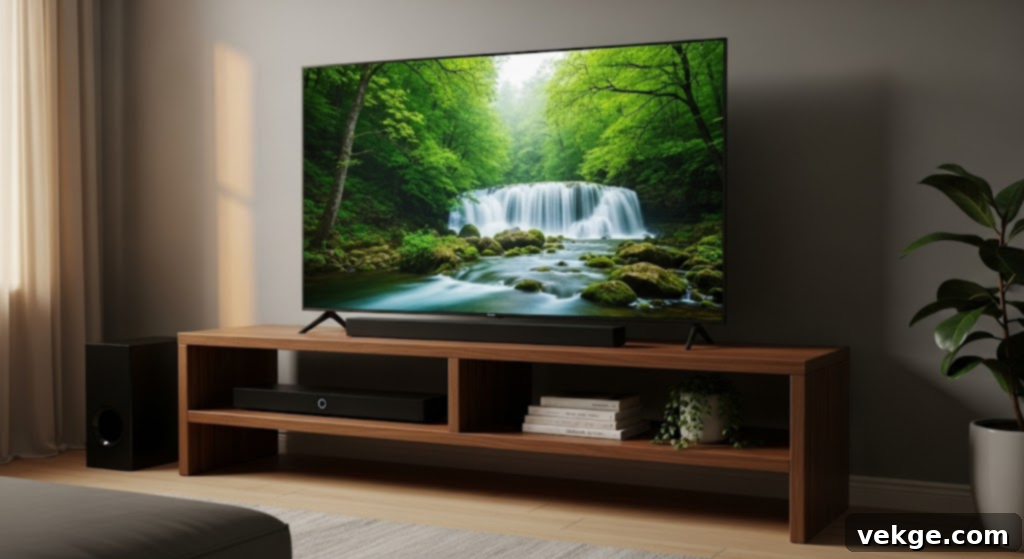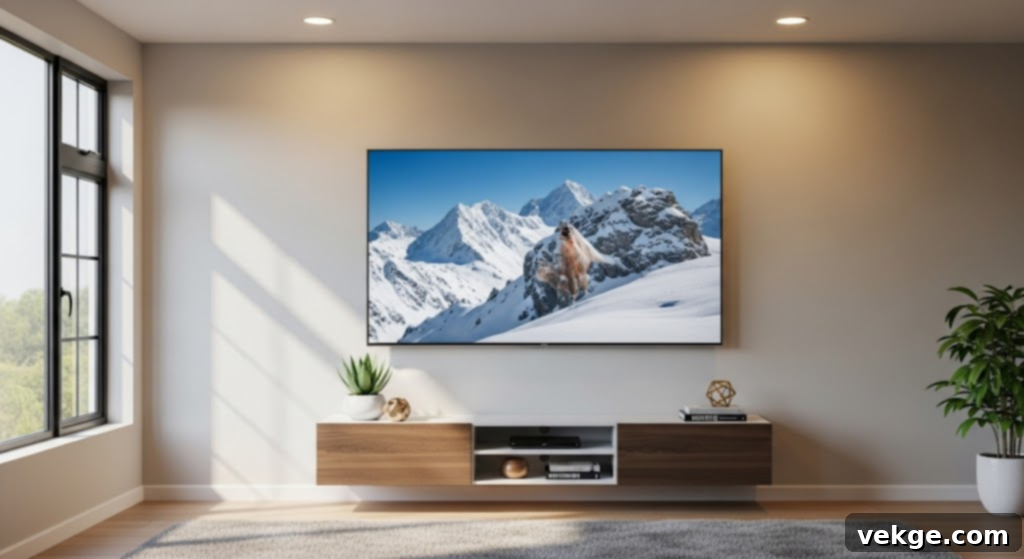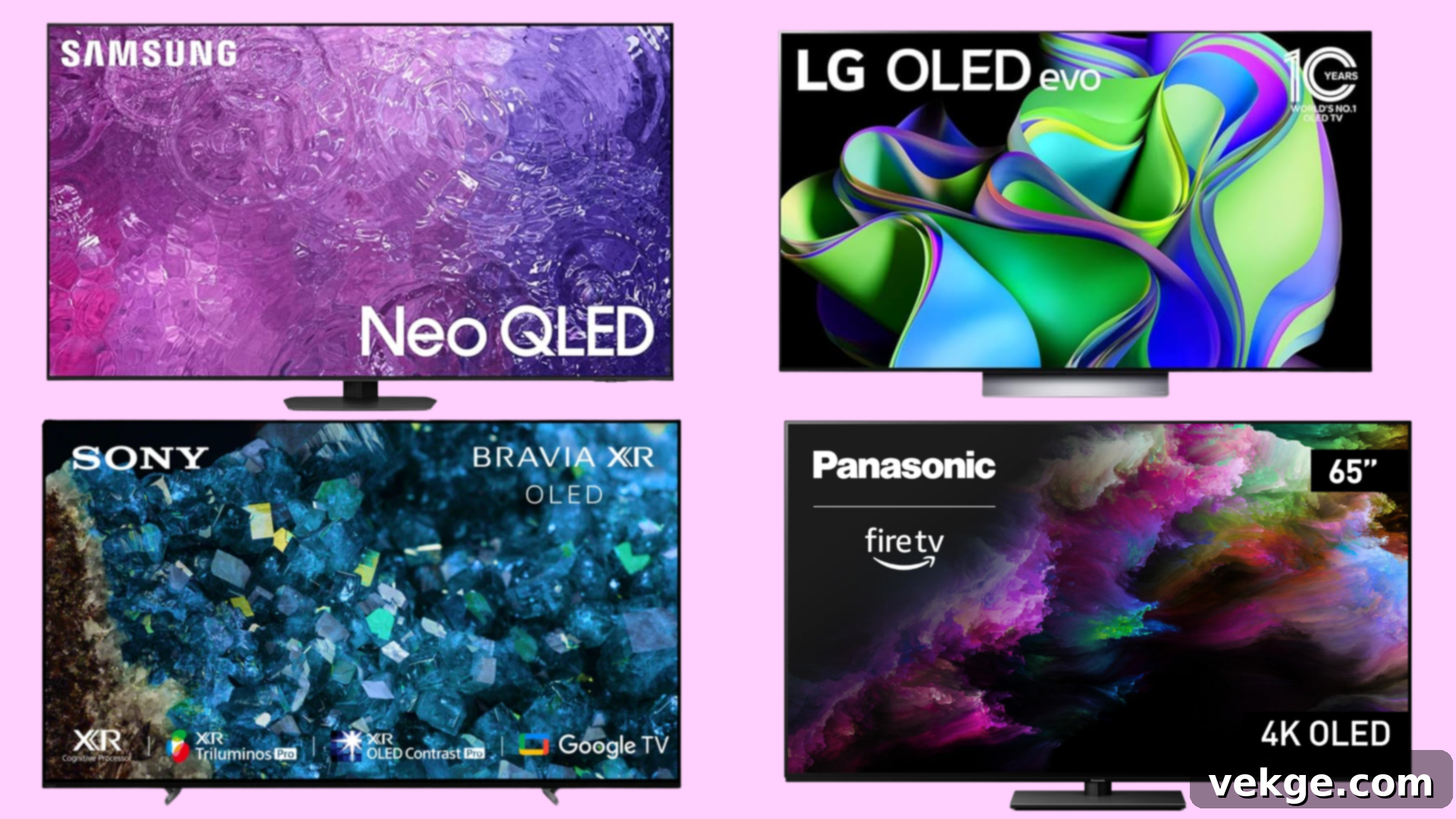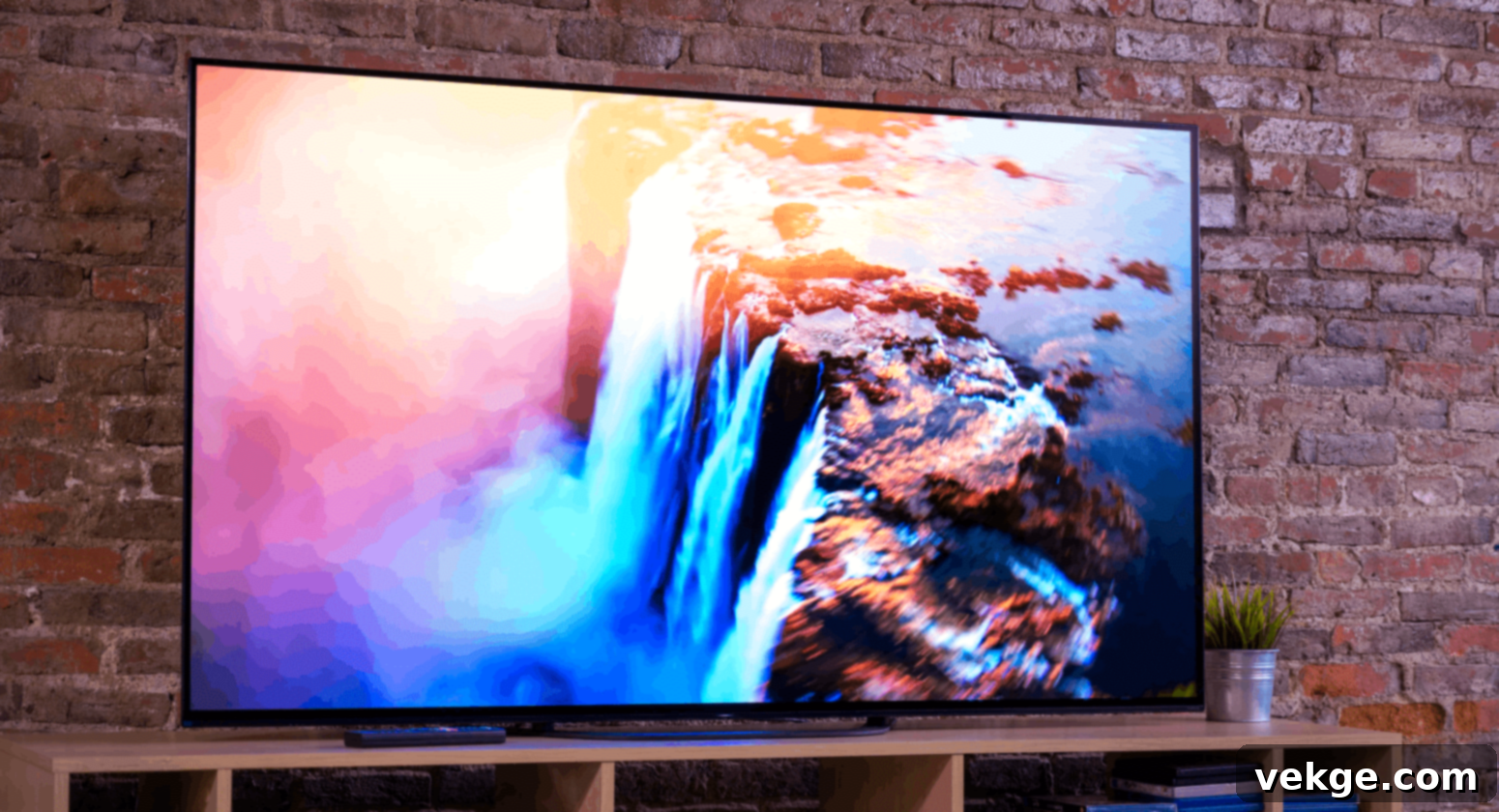Ultimate Guide to 65-Inch TVs: Dimensions, Viewing Distance, and Best Picks for Your Home
Shopping for a new television can be an exciting, yet often confusing, experience. When you set your sights on a spacious 65-inch TV, you’re undoubtedly aiming for that immersive, cinematic experience right in your living room. However, a common concern quickly arises: will a 65-inch TV be too big for my space? You’re certainly not alone in this dilemma.
Many prospective buyers struggle with TV sizing, as “65 inches” sounds undeniably massive. Yet, the desire for a truly impactful home theater setup often leads to gravitating towards larger screens. The complexity further increases when you realize that despite sharing the “65-inch” label, different TV models from various brands can have surprisingly varied external dimensions, which are crucial for planning your space.
Understanding the exact measurements, optimal viewing distances, and suitable room sizes beforehand is paramount. This knowledge can save you from the hassle and cost of returns, or the frustration of a poorly fitted setup. A 65-inch TV could be the perfect centerpiece for your entertainment area, providing a truly grand view, or it might unfortunately overwhelm the room, making viewing uncomfortable and dominating the aesthetics.
In this comprehensive guide, we’ll demystify the 65-inch TV. We’ll explore actual dimensions from popular models, discuss mounting requirements, and even show you how these impressive screens look in various real-room settings. Furthermore, we’ll dive deep into optimal viewing distances and provide concrete room size recommendations to ensure your comfort and enjoyment. By the end, you’ll be equipped with all the information needed to confidently select and integrate your perfect 65-inch TV into your home.
Optimal Viewing Distance for 65-Inch TVs: Comfort and Immersion
Your eyes deserve the best viewing experience, free from strain and fatigue often caused by incorrect TV placement. Achieving the right viewing distance and height is crucial for enjoying those long movie nights or binge-watching sessions without discomfort.
Eye specialists and industry experts generally recommend sitting at least 9 feet (approximately 2.7 to 3 meters) away from a 65-inch 4K screen. This distance allows your eyes to comfortably take in the entire picture without constantly moving back and forth to follow the action, preventing eye strain. For higher resolutions like 4K, you can often sit a bit closer than with older 1080p screens, as the pixel density is much higher, making individual pixels less noticeable at closer distances.
However, viewing distance isn’t the only factor. The height of your television is equally important. To prevent neck strain, mount or place your TV so that the center of the screen aligns with your eye level when you are seated in your primary viewing position. This ergonomic setup ensures natural head and neck posture. If your main seating arrangement involves a low couch or recliner, the TV should be positioned lower on the wall or stand accordingly. Conversely, if you often watch from a standing position or higher seating, adjust the TV’s height to match.
Before making any purchase or installation plans for a 65-inch TV, meticulously measure your room. You’ll need not only the minimum recommended viewing distance of 9 feet but also ample space for furniture, walking paths, and any additional entertainment components. A cramped setup, regardless of how impressive your TV looks on its own, can significantly detract from the overall viewing experience. Always prioritize your comfort and the functionality of your entertainment space.
Consider the room’s layout: is it a dedicated media room or a multi-functional living area? In a smaller, more intimate space, a 65-inch TV might feel overwhelming, whereas in a large, open-plan living area, it can create a fantastic focal point without dominating. For a truly comfortable and immersive experience, aim for a room that allows for the recommended viewing distance while still feeling balanced and spacious.
What Do You Mean by a 65-Inch TV? Unpacking the Dimensions

Here’s a common point of confusion for many consumers: a “65-inch TV” does not mean the television itself is 65 inches wide. This measurement specifically refers to the diagonal distance from one corner of the screen to the opposite corner. So, if you measure from the bottom-left of the display to the top-right, that’s where you’ll get roughly 65 inches.
While the actual screen size might be precisely 65 inches diagonally, or occasionally slightly less (e.g., 64.5 inches for marketing purposes), what truly matters for your room planning and furniture selection are the physical width, height, and depth measurements of the entire television set, including its bezels (the frame around the screen).
Real-World Dimensions You Need to Know
It’s important to remember that every TV brand designs its 65-inch models slightly differently. Factors like bezel thickness, speaker placement, and stand design contribute to variations in overall dimensions. However, most 65-inch models typically fall within these average ranges:
- Average Width (left to right): Approximately 56 to 58 inches (142 to 147 cm)
- Average Height (without stand): Around 32 to 34 inches (81 to 86 cm) – This is the screen’s vertical dimension, important for wall mounting.
- Average Height (with stand): Roughly 34 to 36 inches (86 to 91 cm) – This includes the stand, crucial for TV console compatibility.
- Average Depth (without stand): Typically 1.5 to 3 inches (3.8 to 7.6 cm) – This is how thin the panel is, vital for flush wall mounting.
- Average Depth (with stand): About 10 to 13 inches (25 to 33 cm) – This measurement indicates how much space the TV and its stand will occupy on a console or cabinet.
For instance, a high-end Samsung 65-inch QLED might measure around 57.2 inches wide and be a mere 1.4 inches thick, offering a sleek profile. In contrast, another brand’s 65-inch LED model could be 57.4 inches wide but 3.38 inches thick, potentially requiring different wall mount brackets or affecting its fit in a recessed area.
These seemingly small differences can have a significant impact on your installation. An extra inch in width could prevent it from fitting perfectly into a built-in media cabinet, or additional depth might mean your TV stand needs to be deeper. Always double-check the specific model’s dimensions on the manufacturer’s website or product page before making a purchase. That seemingly insignificant extra inch or two could truly make or break your ideal entertainment setup.
Display Technologies in a 65-Inch TV: Choosing Your Picture Quality
When investing in a large screen like a 65-inch TV, understanding the underlying display technology is crucial, as it directly impacts picture quality, brightness, viewing angles, and overall experience. Here are the primary display options available for 65-inch televisions:
- LCD (Liquid Crystal Display): While less common as a standalone term for modern TVs, LCD refers to the basic panel technology. These displays use a backlight (originally fluorescent, now almost exclusively LED) to illuminate liquid crystals that produce the image. LCDs are known for their affordability and can achieve high resolutions.
- LED (Light-Emitting Diode): Essentially an advanced form of LCD, LED TVs utilize Light-Emitting Diodes as their backlight source instead of traditional fluorescent bulbs. This allows for greater energy efficiency, better contrast, and more precise dimming zones (especially with full-array local dimming). LED TVs are diverse and offer a good balance of performance and price for a 65-inch screen.
- QLED (Quantum Light-Emitting Diode): An upgrade to traditional LED technology, QLED TVs incorporate a quantum dot layer to enhance color and brightness. These quantum dots emit highly saturated and accurate colors when exposed to the LED backlight, resulting in a wider color gamut and superior peak brightness compared to standard LEDs. QLEDs are particularly excellent for bright rooms and delivering vibrant HDR content on a large 65-inch screen.
- OLED (Organic Light Emitting Diode): OLED technology is fundamentally different from LCD/LED/QLED. Instead of a backlight, each individual pixel in an OLED screen generates its own light. This allows for perfect blacks (by turning off individual pixels), infinite contrast, incredibly vibrant colors, and very wide viewing angles. For a 65-inch TV, OLED offers an unparalleled cinematic experience, especially in darker rooms, and is often considered the gold standard for picture quality. It also typically causes the least harm to the eyes due to its pixel-level light control.
- Mini-LED: This is an advancement primarily seen in higher-end LED and QLED TVs. Mini-LED technology uses significantly smaller LEDs for the backlight, allowing for thousands of local dimming zones. This provides much finer control over brightness and contrast, getting closer to OLED-like black levels while retaining the high brightness of QLEDs. It’s an excellent option for a 65-inch screen if you want exceptional contrast and brightness without going for OLED.
Other Important Factors to Consider When Purchasing a 65-Inch TV
Beyond screen size and display technology, a truly great 65-inch TV experience hinges on several other critical specifications. When you’re about to make such a significant investment, looking beyond just the diagonal measurement will ensure you get a TV that perfectly suits your viewing habits and home setup.
1. Refresh Rate
The refresh rate, measured in Hertz (Hz), indicates how many times per second the image on the screen is updated. For a 65-inch TV, a higher refresh rate is highly beneficial. A standard 60Hz TV refreshes 60 times per second, which is adequate for most broadcast TV and movie content. However, for fast-paced action movies, sports, or especially gaming, a 120Hz refresh rate is a game-changer. It provides smoother motion, reduces blur, and eliminates jarring lag, offering a more fluid and enjoyable viewing experience, particularly noticeable on a large 65-inch screen.
2. Sound Quality
While a 65-inch screen delivers impressive visuals, built-in TV speakers often fall short of providing a truly immersive audio experience. The sound quality of a television depends on the wattage (power), the number and placement of speakers, and advanced audio processing. To match the grand visuals of a large screen, consider complementing your 65-inch TV with external audio solutions. A high-quality soundbar or a full home theater system (with multiple speakers) can dramatically enhance your viewing pleasure, offering rich, clear, and powerful sound that brings movies and games to life. Look for TVs that support technologies like Dolby Atmos for object-based, three-dimensional audio.
3. Resolution
Resolution refers to the number of pixels (picture elements) that make up the image on your screen. The higher the number of pixels, the sharper and more detailed the picture quality. For a 65-inch TV, a 4K Ultra HD (3840 x 2160 pixels) resolution is highly desirable and has become the industry standard. At this size, 4K ensures that individual pixels are imperceptible from optimal viewing distances, leading to incredibly crisp and lifelike images. While 8K TVs are emerging, 4K remains the sweet spot for 65-inch models, offering superb clarity with abundant content availability.
4. Connectivity Options
Your TV is the hub of your home entertainment system, so robust connectivity is essential. Ensure your 65-inch TV has enough HDMI ports (ideally HDMI 2.1 for 4K 120Hz gaming and future-proofing), USB ports for external media or accessories, and an Ethernet port for a stable internet connection. Optical audio outputs are useful for older sound systems, while Bluetooth and Wi-Fi are crucial for smart features and wireless peripherals. Check for ports that support the devices you plan to connect, such as gaming consoles, Blu-ray players, soundbars, and streaming sticks.
5. Smart TV Features and Operating System
Modern 65-inch TVs are “smart” and come with an integrated operating system (OS). Popular options include Google TV (Android TV), LG’s webOS, Samsung’s Tizen, and Roku TV. A good smart TV platform offers a user-friendly interface, quick access to popular streaming apps (Netflix, YouTube, Hulu, Disney+, etc.), and often integrates voice assistants like Google Assistant or Alexa. Consider the responsiveness of the OS, the availability of your favorite apps, and how easily you can navigate the menus.
6. HDR (High Dynamic Range) Capabilities
HDR is a major leap in picture quality, offering a wider range of colors, brighter whites, and deeper blacks than standard dynamic range (SDR) content. For a large 65-inch screen, HDR makes an incredible difference, providing more vibrant and realistic images. Look for support for various HDR formats like HDR10, Dolby Vision, HDR10+, and HLG. Dolby Vision and HDR10+ are dynamic HDR formats, meaning they optimize picture quality scene-by-scene for the best possible experience, especially on capable TVs.
How to Install a 65-Inch TV: Stand vs. Wall Mount
Once you’ve chosen your perfect 65-inch TV, the next crucial step is installation. You generally have two main methods: placing it on a suitable TV stand or securely mounting it to a wall. Each method has its own considerations and benefits.
Installing the TV on a Stand

Placing your 65-inch TV on a stand is often the simplest installation method. However, you must ensure that the TV stand or console is robust and durable enough to safely bear the significant weight of your television. A 65-inch TV can weigh anywhere from 40 to 60 pounds (18-27 kg) or more. Beyond weight capacity, the width of the table is critical; it must be wide enough to accommodate the TV’s full width, including its feet or pedestal stand, preventing any risk of it toppling over and causing damage to the TV or injury. Additionally, consider the depth of the stand to ensure the TV sits securely without hanging off the back. Many modern TV stands also offer integrated cable management solutions, which are invaluable for keeping wires tidy and out of sight, contributing to a cleaner aesthetic.
Installing the TV on The Wall

Wall mounting offers a sleek, space-saving aesthetic and allows for ideal viewing height. The first and most critical step is to determine the exact height where the TV needs to be fixed on the wall. As discussed, the center of the screen should align with your seated eye level for optimal comfort. Once the height is set, you need to locate wall studs (wooden or metal framing behind the drywall) to ensure a secure anchor point for your mount. A 65-inch TV is heavy, and mounting it directly into drywall without hitting studs is dangerous.
Next, choose the appropriate VESA-compatible wall mount (fixed, tilting, or full-motion) and safely install it using the required tools and following the manufacturer’s instructions. If you’re not comfortable with DIY installation, especially when dealing with a large and expensive 65-inch TV, it’s highly recommended to call a professional installer to ensure safety and a perfect setup. Professionals can also help with concealing cables within the wall for a truly clean look.
Top Recommended 65-Inch TVs: Our Handpicked Choices

Choosing the right 65-inch TV can indeed feel overwhelming with a multitude of brands and models vying for your attention. Each promises the best picture quality, smart features, and immersive sound. To help simplify your decision, I’ve curated a list of top recommendations based on extensive customer reviews, expert ratings, and key performance features. Please note that prices are approximate and can fluctuate.
Samsung QN90C Neo QLED 65-Inch
- Type: Neo QLED 4K
- Highlight: Exceptional brightness, precise Mini-LED backlight, and outstanding contrast make it perfect for rooms with lots of natural light. Features an anti-glare screen.
- Best For: Bright living rooms, sports enthusiasts, competitive gamers (with low input lag), and general home viewing where vibrant colors are preferred.
- Price: ~$1,997.99
LG OLED C3 65-Inch
- Type: OLED 4K
- Highlight: Renowned for its perfect blacks, infinite contrast, and stunningly accurate colors thanks to self-emissive pixels. Excellent for dark room viewing.
- Best For: Movie aficionados, cinematic viewing experiences, and serious gamers who prioritize deep blacks and fast response times.
- Price: ~$1,129.00
Sony A80L OLED 65-Inch
- Type: OLED 4K
- Highlight: Features Sony’s powerful XR Processor, which excels in upscaling, motion handling, and color processing. Delivers a highly realistic and immersive picture with Dolby Vision support.
- Best For: Home theater enthusiasts, those who appreciate natural and true-to-life picture quality, and viewers who value superior motion clarity.
- Price: ~$1,599.99
Vizio Quantum Pro MQX65QXM 65-Inch
- Type: QLED 4K (Full-Array)
- Highlight: Offers an impressive array of premium features at a budget-friendly price, including Quantum Color, a 120Hz refresh rate, VRR (Variable Refresh Rate), and HDMI 2.1 ports.
- Best For: Gamers and users seeking vivid HDR viewing on a tighter budget without sacrificing key performance features.
- Price: ~$598.00
Panasonic Z85A 65-Inch OLED
- Type: OLED 4K
- Highlight: Powered by the HCX Pro AI Processor MK II for incredible picture optimization, perfect blacks, a 120Hz refresh rate, and integrated Fire TV for seamless streaming. Supports both Dolby Vision IQ & HDR10+.
- Best For: Home theater lovers, serious gamers, and those in bright rooms who desire the premium quality of OLED with smart features and advanced HDR support.
- Price: ~$889
Conclusion: Embracing the Grandeur of a 65-Inch TV
Even in an age dominated by the web and mobile devices, the television continues to hold a cherished place in countless homes. It serves not merely as a medium for entertainment and recreation but also as a powerful tool for bringing family members together under one roof, sharing stories, laughter, and cinematic moments.
When it comes to creating truly memorable viewing experiences, the adage often holds true: the bigger the television, the better the entertainment. A 65-inch TV provides an unparalleled sense of scale and immersion, transforming your living room into a private theater. With its excellent picture quality, especially in 4K resolution, and robust sound capabilities (whether built-in or augmented with a sound system), it delivers visuals that are captivating and audio that is engrossing. You no longer need to huddle close to the screen to fully appreciate your favorite series, movies, or sports events; the expansive display ensures everyone gets a fantastic view from the optimal distance.
In conclusion, when considering your space and budgetary constraints, opting for a 65-inch television is a choice you are unlikely to regret. It represents a significant upgrade in your home entertainment experience, offering magnificent views and a truly immersive atmosphere. By carefully considering the actual dimensions, ensuring proper viewing distance, understanding the display technologies, and choosing a model with the right features and installation method, you can confidently bring home a television that will provide years of joy and breathtaking visuals. Prepare to be amazed by the grandeur and quality that a well-chosen 65-inch TV brings to your home.
